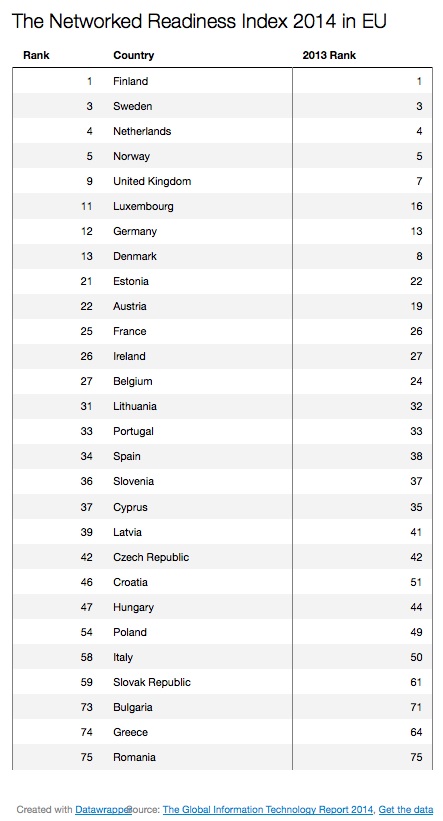Filling the gap in digital infrastructures might not be enough to put Italy in line with countries that are more mature in taking advantage from new information and communication technologies (ICTs). The real restraint for the country’s ability to develop and exploit its digital ecosystem is the political and regulatory environment, unable to keep up with the opportunities offered by new technologies.
This is what emerges from the 13th Global Information Technology report produced by the World Economic Forum, which ranks 148 countries according to the “Networked Readiness Index”. This index considers 54 variables that, taken together, may provide a complete and useful measure of ICT access and impacts on economies. The analysis includes the attitude of governments in supporting ICT developments, the efficacy of laws regulating the field, the affordability of new technologies and the social and economic impacts of ICTs.
The digital divide in Europe
Acknowledged by the European Commission as a pivotal factor of potential economic growth and employment creator for Europe, technological progress is not fully realized in all member states. If we have a look to the data, some European countries are up there at the top of the list for the “Networked Readiness Index”, while many others lie far behind. The different level of digitalization in the member states thus highlights a persisting digital divide within the European Union.

Following the broad classification proposed by the report, we can see that Northern and Western countries in Europe show better results than Southern, Central and Eastern Europe. Among the top ten countries worldwide that dominate the rankings, we can find five member states: Finland, Sweden, the Netherlands, Norway and UK.
Looking further into the details of the digital divide, the report points out that a lack of infrastructures is not the main reason for the gap between countries. Nor is the cost of accessing ICTs, which is similar in all member states. Driving the digital divide among EU states is mainly the political and regulatory environment, which turns out to affect the capacity of businesses to take full advantage of ICT. Countries that are low-ranked for the “Networked Readiness Index” tend to present an inefficient legal framework with respect to ICT, and laws that do not favor innovation and development in this field. A bulky bureaucracy and long processes required to start new businesses are other elements that hold back low-ranked member states.
The economic and social impacts of ITC tend to show lower levels in Central, Eastern and Southern countries compared to Northwestern ones: the number of patents, the proportion of jobs requiring high qualifications, the impacts on education, environment, health, civil participation, these are all factors that show up as differences between high- and low-ranked member states.
Analyzing the elements that characterize the digital divide in EU could offer useful indications for member governments and the European Commission about the strategies and policies to pursue. Investments in ICT infrastructure would not be sufficient to fill the digital gap; it is necessary for member state, especially for low-ranked countries, to build the political and regulatory environment that can allow and foster the economic and social impacts of ICT.
What is the situation of Italy?
Compared with the condition reported in the 2013, Italy shows a worsening of its position in the ranking, falling from the 50th to the 58th position in one year. Excluding Greece, which suffers from a drop of 10 places in the rankings, Italy is the European economy that shows the most severe worsening compared to 2013. It seems that the country failed in progressing fast enough to promote and exploit its digital system.
It’s probably not surprising to note that it is especially the political and regulatory environment that contributes to the situation: the country shows a bad position when considering the effectiveness of law-making bodies and the efficiency of the legal system, lying down in the in the last places of the ranking. The economical environment does not seem to be favorable to innovation for business, and Italy is among the worst countries in the entire sample with respect to venture capital availability, which was rated with a value of only 1.8 in a 7-points scale. The unfavorable environment notwithstanding, personal use of information technology does not appear to be limited in Italy.
As anyone who has ever travelled on an Italian bus or train knows, the country has one of the highest levels of mobile phone subscriptions, and it ranks among the first 50 states for diffusion of computers and internet access at home and on mobile devices. Less widespread is IT usage in business, with a low level of training for staff inside firms. But the prize for the negative result also in this case goes to the government: the report classify Italy al the 144th place among 148 in terms of success of its government to promote ICT.


